Porto Cathedral's Upper Cloister Promenade
As you walk around the cloisters at Porto's Cathedral look for the stairs that lead you up to the second level.
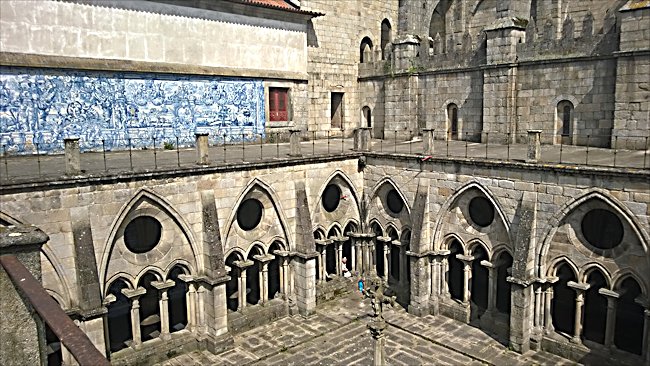
Above the lower cloister internal covered walkway is the upper promenade.
The upper cloister promenade would be where the Abbott of the monastery could bring guests. Some would be from other religious orders, clerics, priests or merchants and dignitaries from the town. It was from this high location that the guests could look down into the Cathedral's colonnaded cloister which was built around a central quadrangle.
They would be able to observe the daily activities of the monks from afar. The guests would not be able to have a disruptive influence on the monks who would be involved in prayer or religious study. Monks who would be involved in making copies of the Bible or other manuscripts would be able to be seen hard at work by the very people who may have commissioned the book.
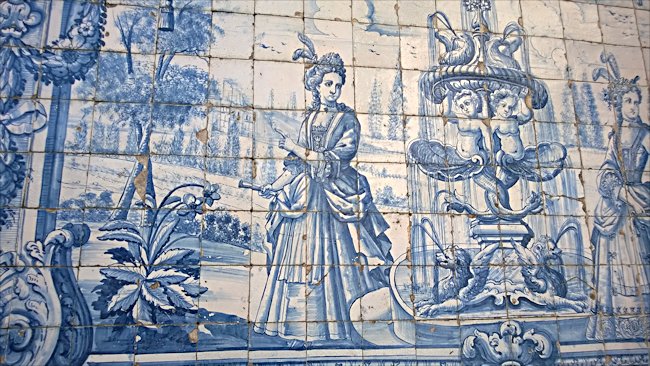
An azulejos blue and white tiled picture of two ladies walking in a country estate.
Two of the walls of the upper cloister promenade are decorated with large blue-and-white polychrome azulejos tiles. They are very attractive but I was shocked at the nature of the painting subject matter. I was expecting more religious imagery. This building is after all the cathedral of Porto.
Instead of pictures of Christ, the disciples, saints and angels, the walls are covered in pictures of country scenes. The one above shows a lady of quality in a highly fashionable expensive dress walking around her country estate. She is accompanied by a friend, although it could be a lady in waiting. She's looking at the baroque water Fountain or standing next to a large flowering shrub. In the background avenues of pencil pine trees have been planted. You can also see a country estate house.
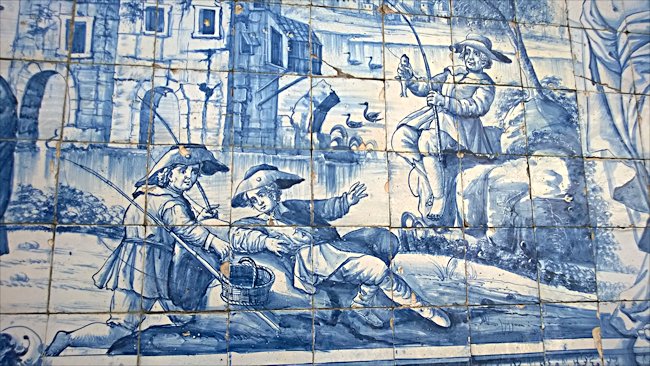
Three men fishing. One has caught a fish whilst the other two talk about the one that got away.
One of the other azulejos tiled paintings depicts a rural scene of three men fishing. They are resting along the banks of the river near what remains of an old stone bridge. This arched bridge has houses built on top of it and also an outside wooden toilet block at the end. The soil went straight into the water. One of the fishermen has been lucky and caught a fish. The one in the middle seems to be telling a typical fisherman's tale to his friend on his right. The way he has his arms outstretched seemed to suggest he is telling his friend how big the fish that got away was.
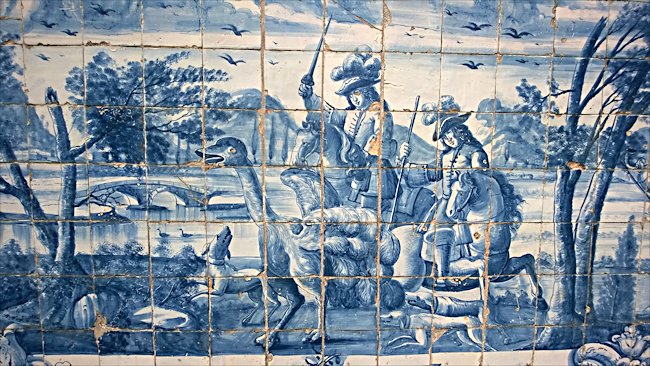
This is a very strange scene to be found in a Roman Catholic Cathedral - Ostrich hunting on horse back with hounds.
You don't normally expect to see a hunting scene on the walls of the cathedral. Especially an exotic animal hunting scene. This is very strange. The azulejos tiled paintings above shows two gentlemen on horseback hunting what looks like an ostrich with dogs. The man on the left is armed with a sword and the horsemen to the right is armed with a spear. Both men are very finely dressed and are obviously wealthy. This event seems to be set in a formal landscape. There is an ornamental arched stone bridge in the foreground and an avenue of pencil pine trees is been planted in a line at the foothills of the mountains.
On another section of the tiled wall the artists have used characters from mythology. Near the outskirts of the castle, whilst being observed from the bushes by three Centaur or Pan like characters, a female archer has shot a winged Dragon through the neck. By the look of the clothes and my stop sandals she's wearing she could be Diana the Huntress.
Another picture shows three women sitting on a cloud surrounded by cherubs. Another one near it is a painting on tile of two gentlemen, very fashionably dressed, meeting in the countryside. They are both wearing long flowing capes, very wide brimmed felt hats, neck ruffles and ornately bowed shoes and pantaloons.
One panel is a water scene with Neptune putting his arms round naked woman whilst riding on the back of two dolphin like sea monsters on top of the sea whilst being observed by cherubs. It is so unusual to see images of pagan gods decorating the walls of a Roman Catholic cathedral.
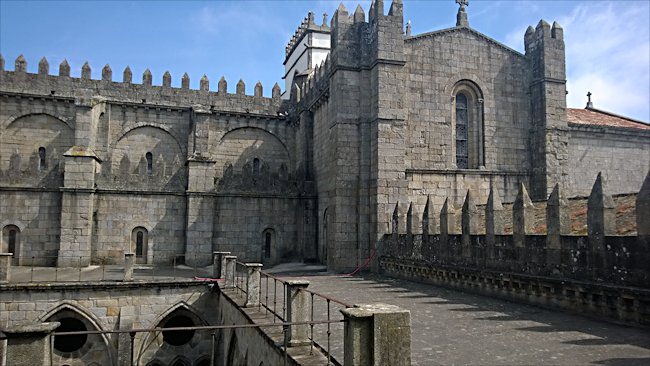
The lower arches are pointed in the Cathedral Cloisters not round; they are gothic not Romanesque
If you stand with your back to the tiled walls and look at the other two parts of the upper cloister promenade you are transported to a different period in time. Upper and lower walls are crenelated to give the appearance of a defended castle. You will notice that the arches in the lower part of the cloister are pointed. These are Gothic arches. The arches in the upper section of the cloister are rounded. These are Romanesque style arches that come from an earlier point in time. By the look of the stonework they appear to be built at the same time. The architect was used mock Romanesque arches to give the appearance that the upper section of the cloisters is much older.
Travel Books


Tweet